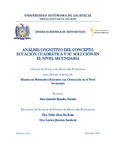
Please use this identifier to cite or link to this item:
http://ricaxcan.uaz.edu.mx/jspui/handle/20.500.11845/1181Full metadata record
| DC Field | Value | Language |
|---|---|---|
| dc.contributor | 773951 | es_ES |
| dc.contributor.advisor | Darly Alina Kú Euán | es_ES |
| dc.contributor.author | Lorena Jimenéz Sandoval | es_ES |
| dc.coverage.spatial | Zacatecas, México | es_ES |
| dc.creator | Rosales Dorado, Sara Gabriela | - |
| dc.date.accessioned | 2019-10-10T18:48:20Z | - |
| dc.date.available | 2019-10-10T18:48:20Z | - |
| dc.date.issued | 2018-12-12 | - |
| dc.identifier | info:eu-repo/semantics/publishedVersion | es_ES |
| dc.identifier.uri | http://ricaxcan.uaz.edu.mx/jspui/handle/20.500.11845/1181 | - |
| dc.description | The study of the quadratic equation concept and its solution begins at the secondary level, and it has been detected that the students present difficulties in the resolution methods, seldom identify the solutions, and if they do, they lack arguments for their interpretation. For this reason the objective of this work is for students to cognitively construct the concept of quadratic equation and its solution, for this we use as a theoretical basis the theory APOE (Actions, Processes, Objects, Schemes). Accordingly, a hypothetical genetic decomposition (DGH) of the mathematical object under study was carried out; Later the teaching cycle of the study concept was designed and finally an interview. The results of the data analysis give evidence that the DG is a viable route for the construction of the quadratic equation concept and its solution, with students of secondary level. | es_ES |
| dc.description.abstract | El estudio del concepto ecuación cuadrática y su solución comienza en el nivel secundaria, y se ha detectado que los estudiantes presentan dificultades en los métodos de resolución, pocas veces identifican las soluciones, y si lo hacen carecen de argumentos para su interpretación. Por tal motivo el objetivo de este trabajo es que los estudiantes construyan cognitivamente el concepto de ecuación cuadrática y su solución, para ello utilizamos como sustento teórico a la teoría APOE (Acciones, Procesos, Objetos, Esquemas). De acuerdo a ello se realizó una descomposición genética hipotética (DGH) del objeto matemático en estudio; posteriormente se diseño el ciclo de enseñanza del concepto de estudio y finalmente una entrevista. Los resultados del análisis de datos dan evidencia que la DGP es una ruta viable para la construcción del concepto ecuación cuadrática y su solución, con estudiantes de nivel secundaria. Palabras | es_ES |
| dc.language.iso | spa | es_ES |
| dc.publisher | Universidad Autónoma de Zacatecas | es_ES |
| dc.relation.isbasedon | Maestría en Matemática Educativa con Orientación en el Nivel Secundaria | es_ES |
| dc.relation.uri | generalPublic | es_ES |
| dc.rights | Atribución-NoComercial-CompartirIgual 3.0 Estados Unidos de América | * |
| dc.rights.uri | http://creativecommons.org/licenses/by-nc-sa/3.0/us/ | * |
| dc.subject.classification | HUMANIDADES Y CIENCIAS DE LA CONDUCTA [4] | es_ES |
| dc.subject.other | ecuaciones cuadráticas | es_ES |
| dc.subject.other | teoría APOE | es_ES |
| dc.subject.other | nivel secundaria | es_ES |
| dc.title | Análisis cognitivo del concepto de ecuación cuadrática y su solución en el nivel secundaria | es_ES |
| dc.type | info:eu-repo/semantics/masterThesis | es_ES |
| Appears in Collections: | *Tesis*-- UA Matemáticas | |
Files in This Item:
| File | Description | Size | Format | |
|---|---|---|---|---|
| 2018 Rosales, S.G..pdf | Tesis de Rosales 2018 | 7,39 MB | Adobe PDF |  View/Open |
This item is licensed under a Creative Commons License
